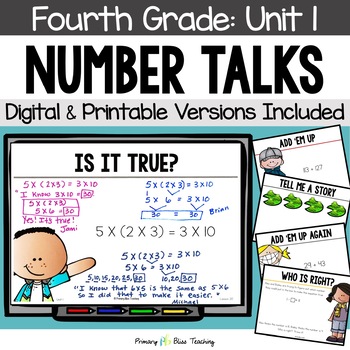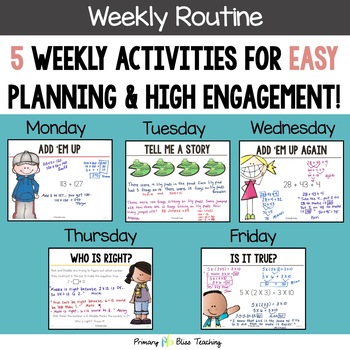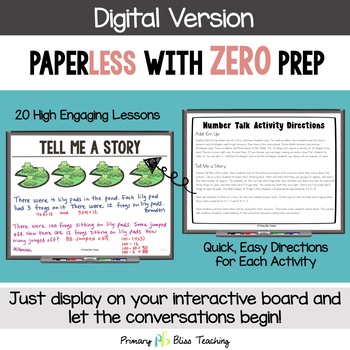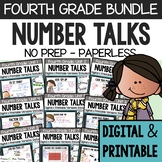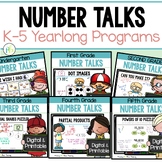Fourth Grade Number Talks Unit 1 for Building Number Sense and Mental Math
- Zip
- Google Apps™

What educators are saying
Also included in
- Math Talks are hands-down the best math warm-up activities for developing number sense and computational fluency. And these Number Talks for fourth grade make implementing Number Talks easier than ever.This seriously NO PREP resource provides daily lessons that are thought-provoking and engaging forPrice $37.00Original Price $49.50Save $12.50
- MATH TALKS are hands-down the BEST math warm-up activities out there for developing NUMBER SENSE and COMPUTATIONAL FLUENCY. And these PAPERLESS Number Talks for grades K-5 make implementing Number Talks EASIER than ever. This seriously NO PREP resource provides DAILY lessons that are thought-provokiPrice $210.00Original Price $304.00Save $94.00
Description
This 4th-grade Number Talks resource is a MUST-HAVE for any teacher wanting their students' computational strategies and mathematical reasoning abilities to soar to new heights.
You will be so excited to watch as your students' mental math abilities get stronger than ever.
These Number Talks are ready to go. Just display them on your interactive whiteboard and get ready for amazing math conversations to begin. Talk about a time saver and getting the biggest bang for your buck!
We've got you covered if you do not yet have an interactive whiteboard. With this resource, you will receive both a DIGITAL and a PRINTABLE version.
The BEST part...It's extremely easy to use and will save you TONS of time. There are 5 activities that students repeat over a 4-week time frame. This makes life oh so easy for teachers, and gives students repeated opportunities to engage in each particular Number Talk activity.
Our students LOVE this daily routine! We just know yours will too!
==============================================================================
INCLUDES:
- 20 Highly Engaging Common Core Aligned Number Talks Lessons: The DIGITAL version is no prep and ready to go. The print version is just print, cut and go!
- Easy Differentiation: Some of the lessons contain more than one Number Talk option for easy-peasy differentiation.
- Variety of Number Talks Activities: Say "YES" to high engagement and "NO!" to boredom! Keeping students highly engaged during Number Talks is key! This product contains the following:
- Monday - Add 'Em Up
- Tuesday - Tell Me A Story
- Wednesday - Add 'Em Up Again
- Thursday - Who Is Right?
- Friday - Is It True?
- Detailed Daily Lesson Plans: These are GREAT for teachers new to number talks, substitute teachers, and teachers who do not have interactive whiteboards.
TWO FREE BONUSES:
- Colorful Silent Hand Signal Posters so students can quietly communicate their thinking in an organized and respectful way.
- Adorable Sentence Starter Posters to aid students in how to organize and share their ideas with others.
==============================================================================
A link to a GOOGLE SLIDES version is included!
========================================================================
HERE'S WHAT OTHER TEACHERS ARE SAYING!
"I bought this unit to see if this is something that I would actually use with my students. I will definitely be buying the year-long product! Save yourself some money and skip straight to the year-long product, it is worth it. My students have been having wonderful number talks with this slideshow and I haven't had to do any planning on my part. It is a great resource to just pull up and use! Love that there is a digital version to be able to pull up on the smartboard instead of printing off too!" -Samantha
"This was a great product! I ended up purchasing all of the units. My students have gained better number sense through the use of this." -Cheri
==============================================================================
WHY NUMBER TALKS?...
Number Talks will get your students engaged in mathematical conversations that will increase their ability to reason mathematically as well as develop their computational fluency skills and their ability to think flexibly about numbers.
But the BEST benefit is that it will turn your reluctant mathematicians into math lovers! When students engage in this short daily activity, they communicate with their peers in a safe environment where it's okay to not be right all the time. It's okay to learn from each other. They learn to discuss various strategies and the effectiveness of those strategies. They begin to take risks. And before you know it, your students who once feared math joyfully jump into solving problems with both feet. It's so exciting to see the transformation!
==============================================================================
WHY DID WE CREATE THIS RESOURCE?
A few years ago we were asked to implement Number Talks in our daily math instruction. After engaging our students in a few of these activities, we were hooked. Our challenge then became to create a variety of problem types in order to keep students engaged and excited about Number Talks. And that is when this Number Talk program was born.
==============================================================================
WHO IS THIS RESOURCE FOR?
-Busy Fourth Grade Teachers
-Substitute Teachers
-Special Education Teachers
-Whole Group Math Instruction
-Small-Group Math Instruction
-Math Intervention
==============================================================================
FAQ
How long do Number Talks take?
It is best if Number Talks are done daily for between 5 and 15 minutes.
Can these Number Talks be displayed on an interactive whiteboard?
We have added a fully digital version of our Number Talks using PowerPoint for your convenience! Just display and go! Number Talks made easy!
Does each month contain 20 different types of Number Talk activities?
Oh goodness no. That would be a bit overwhelming. We have 5 Number Talk activities that are repeated each week using different problems. We are all about keeping it easy for teachers and creating meaningful engagement for kids.
Do I have to print out Number Talk materials for each student each day?
NO! This is a whole group activity. Just display the Number Talk for everyone to see.
Do I need to teach the units in order?
We suggest you teach the Number Talks in order because they spiral and increase in difficulty.
Where are the daily lesson plans?
Daily lesson plans are in the printable version section. These are GREAT for teachers new to number talks as well as for substitute teachers.
==============================================================================
Other NUMBER TALKS Products You Might Love
Fourth Grade Yearlong Number Talks BUNDLE
Fourth Grade Number Talks Unit 2
Fourth Grade Number Talks Unit 3
Fourth Grade Number Talks Unit 4
Fourth Grade Number Talks Unit 5
Fourth Grade Number Talks Unit 6
Fourth Grade Number Talks Unit 7
Fourth Grade Number Talks Unit 8
Fourth Grade Number Talks Unit 9
========================================================================
Click HERE to follow us and receive notifications for SALES, FABULOUS NEW RESOURCES, and FREEBIES!
========================================================================
FREE $$$ - LEAVE FEEDBACK on this product to earn TPT credits that can be used on future purchases!
==============================================================================
Having tech difficulties?
Please SUBMIT a help ticket, TpT has an AMAZING tech team.
==============================================================================
Copyright © Primary Bliss Teaching
Permission to copy for single classroom use only.
Please purchase additional licenses if you intend to share this product.
Cindy & Becky
Team Primary Bliss Teaching

